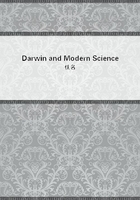
第101章
Before leaving this part of the subject, it is necessary to touch upon another aspect of it. What are these variations in structure which succeed one another in the life-history of an organism? I am conscious that I am here on the threshold of a chamber which contains the clue to some of our difficulties, and that I cannot enter it. Looked at from one point of view they belong to the class of genetic variations, which depend upon the structure or constitution of the protoplasm; but instead of appearing in different zygotes (A zygote is a fertilised ovum, i.e. a new organism resulting from the fusion of an ovum and a spermatozoon.), they are present in the same zygote though at different times in its life-history. They are of the same order as the mutational variations of the modern biologist upon which the appearance of a new character depends. What is a genetic or mutational variation? It is a genetic character which was not present in either of the parents. But these "growth variations" were present in the parents, and in this they differ from mutational variations. But what are genetic characters? They are characters which must appear if any development occurs. They are usually contrasted with "acquired characters," using the expression "acquired character" in the Lamarckian sense. But strictly speaking they ARE acquired characters, for the zygote at first has none of the characters which it subsequently acquires, but only the power of acquiring them in response to the action of the environment. But the characters so acquired are not what we technically understand and what Lamarck meant by "acquired characters." They are genetic characters, as defined above. What then are Lamarck's "acquired characters"? They are variations in genetic characters caused in a particular way. There are, in fact, two kinds of variation in genetic characters depending on the mode of causation. Firstly, there are those variations consequent upon a variation in the constitution of the protoplasm of a particular zygote, and independent of the environment in which the organism develops, save in so far as this simply calls them forth: these are the so-called genetic or mutational variations.
Secondly, there are those variations which occur in zygotes of similar germinal constitution and which are caused solely by differences in the environment to which the individuals are respectively exposed: these are the "acquired characters" of Lamarck and of authors generally. In consequence of this double sense in which the term "acquired characters"may be used, great confusion may and does occur. If the protoplasm be compared to a machine, and the external conditions to the hand that works the machine, then it may be said that, as the machine can only work in one way, it can only produce one kind of result (genetic character), but the particular form or quality (Lamarckian "acquired character") of the result will depend upon the hand that works the machine (environment), just as the quality of the sound produced by a fiddle depends entirely upon the hand which plays upon it. It would be improper to apply the term "mutation" to those genetic characters which are not new characters or new variants of old characters, but such genetic characters are of the same nature as those characters to which the term mutation has been applied. It may be noticed in passing that it is very questionable if the modern biologist has acted in the real interests of science in applying the term mutation in the sense in which he has applied it. The genetic characters of organisms come from one of two sources: either they are old characters and are due to the action of what we call inheritance or they are new and are due to what we call variation. If the term mutation is applied to the actual alteration of the machinery of the protoplasm, no objection can be felt to its use;but if it be applied, as it is, to the product of the action of the altered machine, viz. to the new genetic character, it leads to confusion.
Inheritance is the persistence of the structure of the machine; characters are the products of the working of the machine; variation in genetic characters is due to the alteration (mutation) in the arrangement of the machinery, while variation in acquired characters (Lamarckian) is due to differences in the mode of working the machinery. The machinery when it starts (in the new zygote) has the power of grinding out certain results, which we call the characters of the organism. These appear at successive intervals of time, and the orderly manifestation of them is what we call the life-history of the organism. This brings us back to the question with which we started this discussion, viz. what is the relation of these variations in structure, which successively appear in an organism and constitute its life-history, to the mutational variations which appear in different organisms of the same brood or species. The question is brought home to us when we ask what is a bud-sport, such as a nectarine appearing on a peach-tree? From one point of view, it is simply a mutation appearing in asexual reproduction; from another it is one of these successional characters ("growth variations") which constitute the life-history of the zygote, for it appears in the same zygote which first produces a peach.